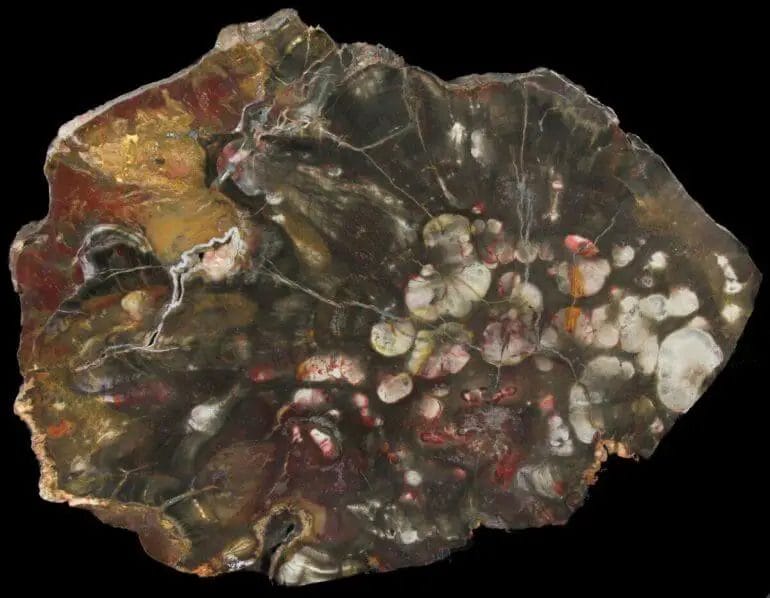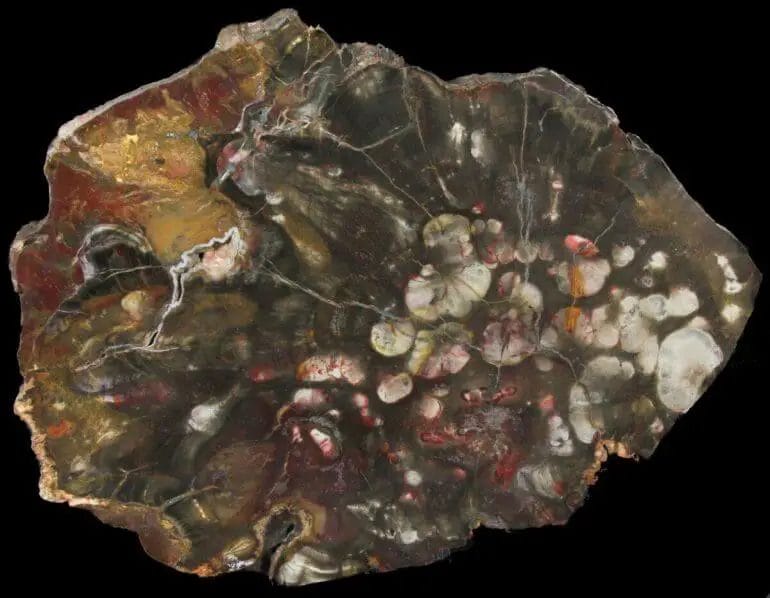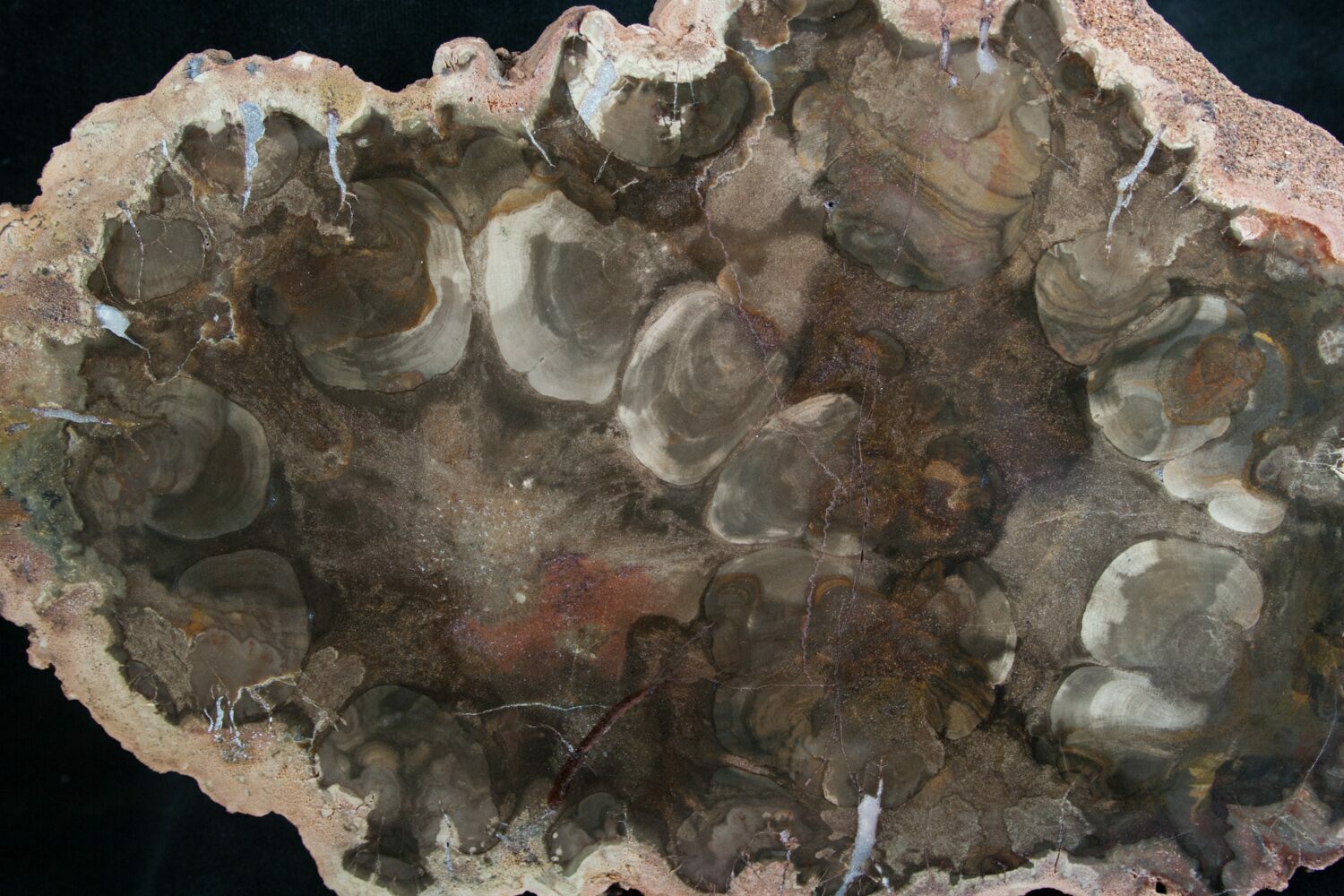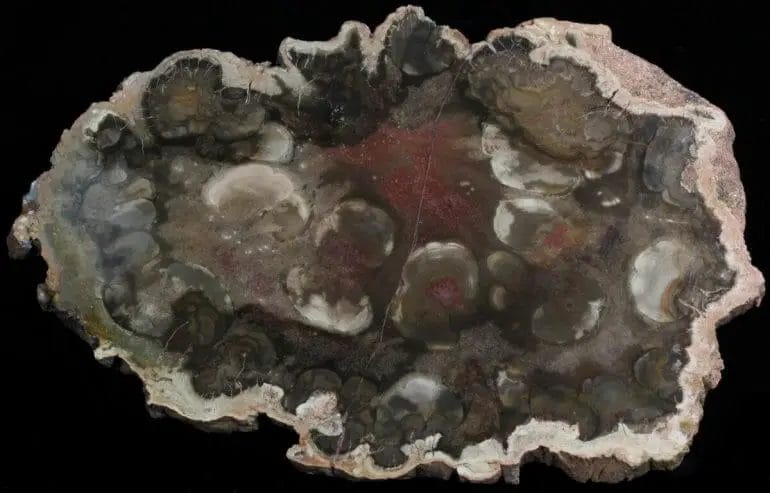Petrified wood is a fascinating and rare natural phenomenon that captures the imagination of geology enthusiasts and collectors alike. This unique fossilized material is formed when organic wood is replaced by minerals, resulting in a stunning stone-like appearance. Due to the specific conditions required for its formation, petrified wood is indeed considered rare. With its intricate pattern of preserved wood fibers and vibrant mineral colors, petrified wood is highly sought after for its beauty and scientific value. Discover the wonder of this extraordinary natural treasure.

Unveiling the Mysteries of Rare Petrified Wood
Have you ever wondered about the fascinating world of petrified wood? This unique natural phenomenon has captivated scientists, geologists, and nature enthusiasts for centuries. In this section, we will delve into the intriguing mysteries surrounding rare petrified wood and uncover the secrets hidden within these ancient treasures.

The Formation Process
Petrified wood is formed through a process called mineralization, which takes place over millions of years. It begins when a tree is buried under layers of sediment or volcanic ash, cutting off the oxygen supply and preventing decomposition. As minerals-rich groundwater permeates through the tree’s cells, it starts to replace the organic material, slowly turning it into stone.
The replacement process is intricate, as various minerals, such as silica, iron, and manganese, seep into the wood’s cellular structure. This gradual infusion of minerals not only preserves the intricate details of the original tree but also creates stunning hues and patterns within the petrified wood.
The Significance of Rare Petrified Wood
Rare petrified wood holds immense scientific and historical value. These ancient relics provide valuable insights into the Earth’s geological history, offering clues about the climate, flora, and fauna of bygone eras. Scientists study the composition and structure of petrified wood to gain a deeper understanding of the planet’s evolutionary processes.
Moreover, petrified wood serves as a window into the past, allowing us to visualize extinct ecosystems and understand the changes that have occurred over millions of years. By examining the growth rings and patterns within the wood, researchers can determine the age of the tree and infer details about its environment.
Uncovering the Hidden Treasures
Exploring regions abundant in rare petrified wood can be an exciting endeavor. There are several renowned sites around the world that offer glimpses into this mesmerizing world. One such place is the Petrified Forest National Park in Arizona, USA. With its sprawling landscapes and diverse collection of petrified logs, it provides an awe-inspiring experience for visitors.
Throughout the park, visitors can marvel at the vibrant colors and intricate patterns of the petrified wood. The Rainbow Forest Museum offers an in-depth look at the formation process, showcasing a variety of fossilized specimens and explaining the intricate science behind their creation.
Other notable locations for rare petrified wood include the Petrified Forest of Lesvos in Greece, the Holbrook Petrified Forest State Park in Utah, USA, and the Isle of Wight in the United Kingdom.
The Beauty and Value of Petrified Wood
Aside from its scientific significance, rare petrified wood is also highly valued for its stunning beauty and unique characteristics. The vibrant colors, ranging from deep reds and oranges to brilliant blues and greens, make each piece a work of art.
Collectors and enthusiasts seek out petrified wood with intricate patterns and eye-catching details. These remarkable specimens are not only admired for their aesthetic appeal but also cherished for their historical and geological importance.
Preserving and Protecting Petrified Wood
As custodians of nature’s wonders, it is our responsibility to preserve and protect rare petrified wood. Many national parks and protected sites have strict regulations against the removal or disturbance of petrified wood, ensuring its preservation for future generations to enjoy.
When visiting these sites, it is essential to respect the rules and guidelines in place. Admire the beauty of petrified wood in its natural surroundings and leave it undisturbed for others to appreciate.
In Summary
Rare petrified wood is a window into the past, offering a glimpse into ancient ecosystems and the Earth’s geological history. Through a meticulous process of mineralization, these natural wonders are transformed into stone, preserving their intricate details for millions of years. Whether for scientific research or aesthetic appreciation, rare petrified wood holds immense value and should be protected for future generations to cherish.

Petrified wood: A collector’s dream come true
In the world of natural wonders, petrified wood stands out as a fascinating and unique geological phenomenon. It captures the imagination with its stunning beauty and extraordinary history. For collectors and enthusiasts, petrified wood is a dream come true. In this section, we will explore the mesmerizing world of petrified wood and delve into why it is a coveted item for collectors.
1. What is petrified wood?
Petrified wood is the result of a process called petrification, where organic material is replaced by minerals over time. It starts with fallen or dead trees that get buried in sediment, preventing them from decomposing completely. The minerals in the surrounding sediment gradually seep into the wood, replacing the organic matter cell by cell.
Over millions of years, the wood’s cellular structure is transformed into stone, while retaining the appearance and texture of wood. The minerals that replace the organic material give petrified wood its vibrant colors and intricate patterns.
2. How is petrified wood formed?
The process of petrification begins when a fallen tree is quickly buried by sediment, such as volcanic ash or river sediments. This rapid burial cuts off the oxygen supply, slowing down the decay process. Over time, minerals present in groundwater permeate the wood, replacing the original plant material. The most common minerals responsible for petrification are silica, quartz, and various oxides.
The petrification process may take thousands of years, and the colors and patterns that develop depend on the type of minerals present and their impurities. Iron oxides, for example, create vibrant reds and yellows, while manganese oxides produce shades of purple and black.
3. The allure of petrified wood for collectors
Petrified wood holds a special place in the hearts of collectors due to its striking appearance and rarity. Each piece of petrified wood tells a story about Earth’s history, preserving the memory of ancient forests and ecosystems. The unique patterns and colors found in petrified wood make each specimen a one-of-a-kind piece of art.
Collectors appreciate petrified wood for its aesthetic value as well as its scientific and educational significance. It provides a tangible connection to Earth’s past and allows us to study the ancient flora and geological processes that shaped our planet.
3.1 Rarity and uniqueness
Petrified wood is relatively rare, making it highly sought after by collectors. It requires specific geological conditions for its formation, limiting its availability. Additionally, each piece of petrified wood has its own distinct patterns and colors, ensuring that no two specimens are identical.
3.2 Geological and scientific value
From a scientific perspective, petrified wood provides valuable insights into past ecosystems and environmental conditions. By studying petrified wood, scientists can learn about ancient climates, flora, and even the presence of extinct species. It serves as a time capsule, offering a glimpse into Earth’s distant past.
3.3 Decorative and artistic appeal
Many collectors are drawn to petrified wood for its decorative and artistic appeal. Its unique patterns and colors make it a versatile material for various applications, such as jewelry, sculptures, and home decor. Petrified wood specimens can be polished and shaped, highlighting their natural beauty and creating stunning artistic pieces.
4. How to collect petrified wood
If you’re interested in starting a petrified wood collection, there are a few important considerations to keep in mind:
- Research and identification: Familiarize yourself with the different types of petrified wood and their characteristics. This knowledge will help you identify authentic specimens and distinguish them from imitations.
- Legalities: Ensure that you are collecting petrified wood legally. Some areas have restrictions on collecting or require permits. Always respect private property and natural reserves.
- Field trips and excavation: Joining field trips or guided excavation tours can provide the opportunity to find petrified wood in its natural habitat. These experiences allow you to witness the thrill of discovering your own specimens.
- Acquiring from reputable dealers: If you prefer to purchase petrified wood, seek out reputable dealers who can provide authentic specimens with provenance.
- Preservation and care: Petrified wood is durable, but it still requires proper care and maintenance. Avoid exposure to extreme temperatures and moisture, and periodically clean and polish your specimens to maintain their luster
The Allure of Rare Petrified Wood for Interior Design
Petrified wood, with its unique beauty and history, has become a popular choice in interior design. This ancient and captivating material adds a touch of natural elegance and intrigue to any space. In this section, we will explore the allure of rare petrified wood and how it can be incorporated into interior design.
The Fascinating Origins of Petrified Wood
Petrified wood is the result of a natural process that occurs over thousands of years. It begins when trees are buried under layers of sediment, preventing decomposition. As time passes, groundwater rich in minerals seeps into the wood, replacing its organic material with minerals such as quartz, opal, and jasper. This slow process transforms the wood into stone, preserving its intricate grain patterns and organic textures.
The rarity of petrified wood lies in its formation conditions. It requires a unique combination of factors, including specific geological conditions, the right types of trees, and a lengthy preservation process. These factors contribute to the limited supply and the allure of rare petrified wood.
The Unique Aesthetic Appeal
One of the main reasons petrified wood is highly sought after in interior design is its captivating aesthetic appeal. Each piece of petrified wood is a one-of-a-kind work of art, showcasing the individuality of nature’s craftsmanship. The vibrant colors, intricate grain patterns, and polished surfaces make petrified wood a stunning focal point in any room.
With its timeless beauty, petrified wood seamlessly blends with various interior design styles. It adds warmth and organic texture to modern and minimalist spaces, while also enhancing the rustic charm of traditional or eclectic designs. Whether used as a coffee table, countertop, or accent piece, petrified wood brings a touch of natural elegance to any space.
Creating a Statement Piece
One of the most exciting aspects of using rare petrified wood in interior design is the opportunity to create a statement piece. Due to its durability and unique characteristics, petrified wood can be transformed into custom furniture, such as dining tables, side tables, or consoles. These one-of-a-kind pieces not only serve a practical purpose but also become conversation starters and artistic focal points.
When incorporating petrified wood into interior design, it’s essential to consider its natural beauty and showcase it properly. Opting for minimalistic designs that let the wood take center stage allows its intricate patterns and unique colors to shine through. The contrast between the ancient wood and sleek contemporary designs can create a visually stunning juxtaposition.
Bringing Nature Indoors
Petrified wood allows homeowners to bring a piece of nature indoors. It adds an organic and earthy element to any space, creating a sense of tranquility and connection to the natural world. Whether used as a coffee table, bookshelf, or wall art, petrified wood acts as a reminder of the beauty and resilience of nature.
In summary, petrified wood’s allure in interior design stems from its fascinating origins, unique aesthetic appeal, the opportunity to create statement pieces, and its ability to bring nature indoors. By incorporating rare petrified wood into interior design, homeowners can create spaces that are not only visually striking but also tell a story that spans millions of years.
Protecting and Preserving Rare Petrified Wood for Future Generations
One of the Earth’s remarkable natural wonders is the formation of petrified wood. Petrified wood is a fossilized form of ancient trees, where the organic matter is replaced by minerals over thousands of years. It provides a glimpse into the history of our planet, offering valuable insights into the past. However, due to various factors like natural erosion, human interference, and climate change, rare petrified wood specimens are at risk of being lost forever. In this section, we will explore the importance of protecting and preserving rare petrified wood for future generations.
1. Conservation and Restoration Efforts
Conservation and restoration efforts play a vital role in safeguarding rare petrified wood. By implementing strict regulations and guidelines, we can ensure that these precious artifacts are protected from illegal collection, vandalism, and destruction. National parks and protected areas, where petrified wood deposits are present, need adequate signage, security measures, and educational programs to raise awareness among visitors about the significance of preserving these natural treasures.
Furthermore, restoration projects can be undertaken to repair and preserve damaged or deteriorating petrified wood specimens. This involves using specialized techniques and materials to stabilize and reinforce the fragile structures, preventing further degradation over time.
2. Scientific Research and Documentation
Scientific research and documentation are integral to the preservation of rare petrified wood. By conducting thorough studies, researchers can gain valuable insights into the geological, botanical, and climatic conditions of the ancient world. This knowledge not only contributes to our understanding of Earth’s history but also aids in identifying potential threats and vulnerabilities facing petrified wood ecosystems today.
Proper documentation of petrified wood specimens is essential for maintaining an accurate record of their origin, characteristics, and unique qualities. This information is crucial for future research, identification, and authentication purposes. Digital imaging and cataloging systems are increasingly being employed to create comprehensive databases that can be easily accessed by researchers worldwide.
3. Public Education and Awareness
Public education and awareness initiatives are key in fostering a sense of responsibility and appreciation for rare petrified wood. Educational programs can be developed in collaboration with schools, museums, and community organizations to raise awareness about the significance of petrified wood as a scientific and cultural resource. This can include guided tours, workshops, and interactive exhibits that highlight the value of protecting these natural wonders.
Additionally, community involvement and engagement are crucial for the long-term preservation of petrified wood. By encouraging local residents and visitors to act as stewards of their natural surroundings, we can foster a sense of ownership and pride in preserving these unique landscapes. This can be achieved through volunteer programs, citizen science initiatives, and public participation in conservation efforts.
4. Environmental Stewardship
Environmental stewardship is paramount in safeguarding rare petrified wood. This involves implementing sustainable practices and policies to mitigate the impact of human activities on petrified wood ecosystems. It includes measures such as responsible tourism guidelines, land-use planning, and habitat restoration initiatives.
Efforts should also be made to address the effects of climate change on petrified wood formations. Rising temperatures, increased precipitation, and altered weather patterns can pose significant risks to the stability and integrity of these ancient structures. By advocating for climate action and promoting sustainable lifestyles, we can contribute to the long-term preservation of petrified wood and its ecosystems.
5. Collaboration and International Cooperation
Collaboration and international cooperation are essential for effectively protecting and preserving rare petrified wood. By sharing knowledge, resources, and best practices, scientists, researchers, and conservationists can work together to address the challenges faced by these unique geological formations.
International treaties, agreements, and conventions can provide a framework for cross-border cooperation in preserving petrified wood. These initiatives encourage countries to harmonize their conservation efforts, exchange information, and collaborate on research projects aimed at better understanding and protecting petrified wood worldwide.
In summary, protecting and preserving rare petrified wood for future generations is of utmost importance. Through conservation and restoration efforts, scientific research and documentation, public education and awareness, environmental stewardship, and collaboration, we can ensure that these natural wonders continue to inspire and educate generations to come.
FAQs
Is petrified wood rare?
Yes, petrified wood is considered rare. It forms over thousands of years when the organic material of wood is replaced with minerals. The process requires specific conditions like the presence of water and sediment. Due to the unique combination of factors required for petrification, it is relatively uncommon to find well-preserved and complete specimens of petrified wood.
Conclusion
In conclusion, petrified wood is a fascinating and rare natural phenomenon. Its formation is a result of the gradual replacement of organic materials with minerals over thousands of years. Due to its unique appearance and historical significance, petrified wood has become highly sought after by collectors, scientists, and enthusiasts. The scarcity and increasing demand for petrified wood have made it a valuable and prized geological specimen. Its intricate patterns, vibrant colors, and rich textures make it a popular choice for decorative and ornamental purposes. Whether used in jewelry, furniture, or as a display piece, petrified wood continues to capture the awe and admiration of people worldwide.
